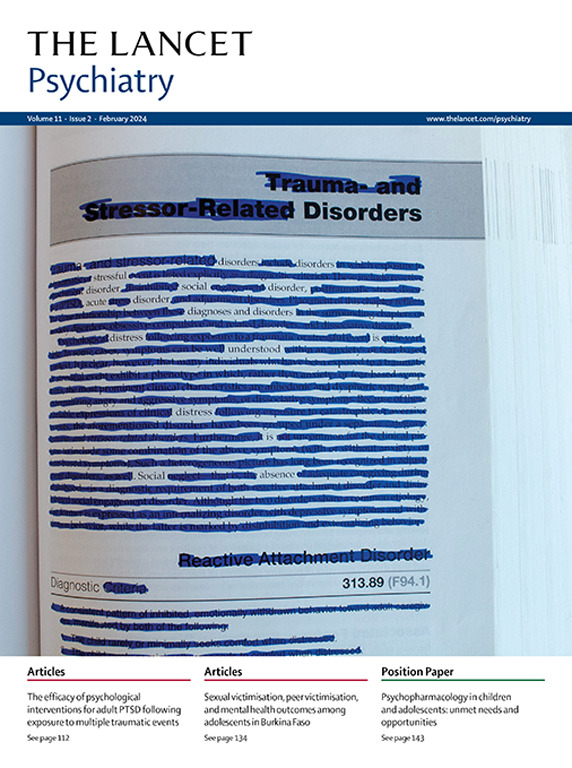Comparative cardiovascular safety of medications for attention-deficit hyperactivity disorder in children, adolescents, and adults: a systematic review and network meta-analysis
IF 30.8
1区 医学
Q1 PSYCHIATRY
引用次数: 0
Abstract
Background
Concerns about the cardiovascular safety of medications used for the treatment of attention-deficit hyperactivity disorder (ADHD) remain. We aimed to compare the effects of pharmacological treatments for ADHD on haemodynamic values and electrocardiogram (ECG) parameters in children, adolescents, and adults.Methods
For this systematic review and network meta-analysis, we searched 12 electronic databases, including Cochrane CENTRAL, Embase, PubMed, and the WHO International Clinical Trials Registry Platform, from database inception to Jan 18, 2024, for published and unpublished randomised controlled trials comparing amphetamines, atomoxetine, bupropion, clonidine, guanfacine, lisdexamfetamine, methylphenidate, modafinil, or viloxazine against each other or placebo. Primary outcomes were change in systolic blood pressure (SBP) and diastolic blood pressure (DBP), measured in mm Hg, and pulse, measured in beats per minute, at timepoints closest to 12 weeks, 26 weeks, and 52 weeks. Summary data were extracted and pooled in random-effects network meta-analyses. Certainty of evidence was assessed with the Confidence in Network Meta-Analysis (CINeMA) framework. This study was registered with PROSPERO, CRD42021295352. Before study initiation, we contacted representatives of a UK-based charity of people with lived experience of ADHD—the ADHD Foundation—regarding the relevance of the topic and the appropriateness of the outcomes chosen.Findings
102 randomised controlled trials with short-term follow-up (median 7 weeks [IQR 5–9]) were included, encompassing 13 315 children and adolescents (aged ≥5 years and <18 years; mean age 11 years [SD 3]; of available data, 9635 [73%] were male and 3646 [27%] were female; of available data, 289 [2%] were Asian, 1719 [15%] were Black, and 8303 [71%] were White) and 9387 adults (≥18 years, mean age 35 years [11]; of available data, 5064 [57%] were male and 3809 [43%] were female; of available data, 488 [6%] were Asian, 457 [6%] were Black, and 6372 [79%] were White). Amphetamines, atomoxetine, lisdexamfetamine, methylphenidate, and viloxazine led to increments in haemodynamic values in children and adolescents, adults, or both. In children and adolescents, mean increase against placebo ranged from 1·07 (95% CI 0·36–1·79; moderate CINeMA confidence) with atomoxetine to 1·81 (1·05–2·57; moderate) with methylphenidate for SBP; from 1·93 (0·74–3·11; high) with amphetamines to 2·42 (1·69–3·15; low) with methylphenidate for DBP; and from 2·79 (1·05–4·53; moderate) with viloxazine to 5·58 (4·67–6·49; high) with atomoxetine for pulse. In adults, mean increase against placebo ranged from 1·66 (95% CI 0·38–2·93; very low) with methylphenidate to 2·3 (0·66–3·94; very low) with amphetamines for SBP; from 1·60 (0·29–2·91; very low) with methylphenidate to 3·07 (0·69–5·45; very low) with lisdexamfetamine for DBP; and from 4·37 (3·16–5·59; very low) with methylphenidate to 5·8 (2·3–9·3; very low) with viloxazine for pulse. Amphetamines, lisdexamfetamine, or methylphenidate were not associated with larger increments in haemodynamic values compared with atomoxetine or viloxazine in either children and adolescents or adults. Guanfacine was associated with decrements in haemodynamic values in children and adolescents (mean decrease against placebo of –2·83 [95% CI –3·8 to –1·85; low CINeMA confidence] in SBP, –2·08 [–3 to –1·17; low] in DBP, and –4·06 [–5·45 –2·68; moderate] in pulse) and adults (mean decrease against placebo of –10·1 [–13·76 to –6·44; very low] in SBP, –7·73 [–11·88 to –3·58; very low] in DBP, and –6·83 [–10·85 to –2·81; very low] in pulse). Only four RCTs informed on effects in the medium term and none on the long term.Interpretation
Practitioners should monitor blood pressure and pulse in patients with ADHD treated with any pharmacological intervention, and not stimulants only. Given the short duration of available randomised controlled trials, new research providing insights on the causal effects of ADHD medications on cardiovascular parameters in the longer term should be funded.Funding
National Institute for Health and Care Research.儿童、青少年和成人治疗注意缺陷多动障碍药物的心血管安全性比较:系统综述和网络荟萃分析
背景:对于用于治疗注意力缺陷多动障碍(ADHD)的药物的心血管安全性的担忧仍然存在。我们的目的是比较ADHD药物治疗对儿童、青少年和成人血流动力学值和心电图参数的影响。方法本系统综述和网络荟萃分析,我们检索了12个电子数据库,包括Cochrane CENTRAL、Embase、PubMed和WHO国际临床试验注册平台,从数据库建立到2024年1月18日,检索了已发表和未发表的随机对照试验,比较安非他明、阿托莫西汀、安非他酮、克拉定、胍法辛、利地胺非他明、哌醋甲酯、莫达非尼或维洛嗪相互或安慰剂的疗效。主要结局是收缩压(SBP)和舒张压(DBP)的变化,单位为毫米汞柱,以及脉搏,单位为每分钟跳动,在最接近12周、26周和52周的时间点。摘要数据被提取并汇集在随机效应网络荟萃分析中。证据的确定性用网络元分析(CINeMA)框架进行评估。本研究注册号为PROSPERO, CRD42021295352。在研究开始之前,我们联系了一家英国慈善机构的代表,他们是有过ADHD生活经历的人——ADHD基金会——关于主题的相关性和选择结果的适当性。研究结果:纳入102项短期随访(中位数为7周[IQR 5 - 9])的随机对照试验,包括13 315名儿童和青少年(年龄≥5岁和18岁;平均年龄11岁[SD 3];在现有资料中,男性9635例(73%),女性3646例(27%);在现有资料中,亚洲人289例(2%),黑人1719例(15%),白人8303例(71%),成年人9387例(≥18岁,平均年龄35岁;在现有资料中,男性5064例(57%),女性3809例(43%);在现有资料中,488例(6%)为亚洲人,457例(6%)为黑人,6372例(79%)为白人。安非他明、托莫西汀、利地安非他明、哌醋甲酯和维洛嗪导致儿童、青少年、成人或两者的血流动力学值增加。在儿童和青少年中,与安慰剂相比,平均增加1.07 (95% CI 0.36 - 0.79;中度CINeMA置信度),托莫西汀为1.81 (1.05 - 2.57;中度)用哌甲酯治疗收缩压;从1.93 (0.74 - 3.11);高)与安非他明的比值为2.42 (1.69 ~ 3.15;低)用哌甲酯治疗DBP;2·79(1·05-4·53;中度)与维洛嗪的比值为5.58 (4.67 ~ 6.49;高)用托莫西汀作脉搏。在成人中,与安慰剂相比,平均增加1.66 (95% CI 0.38 - 2.93;非常低),哌醋甲酯为2·3(0·66-3·94;非常低)用安非他明治疗收缩压;从1·60(0·29-2·91;非常低),哌醋甲酯为3.07 (0.69 - 5.45;非常低)用利地塞米明治疗DBP;4·37(3·16-5·59;非常低),哌醋甲酯为5·8(2·3 - 9·3;很低)用维洛嗪治疗脉搏。在儿童、青少年或成人中,与托莫西汀或维洛嗪相比,安非他明、利德氨苯他明或哌醋甲酯与血流动力学值的较大增量无关。胍法辛与儿童和青少年血流动力学值的降低相关(与安慰剂相比,平均降低-2·83 [95% CI -3·8至-1·85;SBP的CINeMA置信度低,-2·08[-3 ~ -1·17];DBP为- 4.06[- 5.45 -2·68];中度](脉搏)和成人(与安慰剂相比平均减少- 10.1[- 13.76至- 6.44;收缩压极低,- 7.73 [- 11.88 ~ - 3.58];DBP极低,-6·83[-10·85 ~ -2·81];(脉冲很低)。只有四项随机对照试验报告了中期效果,没有一项报告了长期效果。从业人员应监测接受任何药物干预治疗的ADHD患者的血压和脉搏,而不仅仅是兴奋剂。鉴于现有的随机对照试验持续时间较短,应该资助新的研究,以深入了解ADHD药物对心血管参数的长期因果影响。资助国家健康和护理研究所。
本文章由计算机程序翻译,如有差异,请以英文原文为准。
求助全文
约1分钟内获得全文
求助全文
来源期刊

Lancet Psychiatry
PSYCHIATRY-
CiteScore
58.30
自引率
0.90%
发文量
0
期刊介绍:
The Lancet Psychiatry is a globally renowned and trusted resource for groundbreaking research in the field of psychiatry. We specialize in publishing original studies that contribute to transforming and shedding light on important aspects of psychiatric practice. Our comprehensive coverage extends to diverse topics including psychopharmacology, psychotherapy, and psychosocial approaches that address psychiatric disorders throughout the lifespan. We aim to channel innovative treatments and examine the biological research that forms the foundation of such advancements. Our journal also explores novel service delivery methods and promotes fresh perspectives on mental illness, emphasizing the significant contributions of social psychiatry.
 求助内容:
求助内容: 应助结果提醒方式:
应助结果提醒方式:


